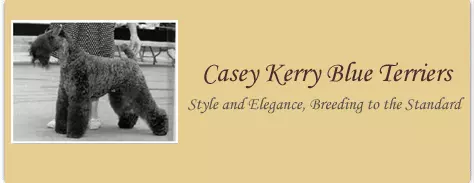The two dogs pictured above, Ch. Townshend's Fair Chance (Casey) and Ch. South County Muffet (Muffet), are the foundation dogs of Casey Kerry Blue Terriers. You can click on their pictures to view their pedigrees. We consider these dogs our foundation because they made significant contributions to the establishment of our line. Both were excellent show dogs in their day, but more than that they were complimentary in type and very sound.
In the fifties and sixties, when we were getting our start in the breed, there was no Internet and there were not half a dozen or more dog shows every weekend. Most dog clubs held single day shows and living in Colorado, you had to travel out of state, a journey of eight hours or more, to show dogs regularly. There were some dog magazines, but not the so-called "brag rags" of today, so you didn't see the current crop of winners as easily as you can now. Our quest for a Kerry to show involved years of researching lines, traveling to out of state shows just to make contacts, lots of long distance calls and a lot of mentoring from long time breeders and exhibitors. We put a deposit on a puppy from the Berry's of O'Tamarack, but when they decided to keep the puppy and show it themselves, we resumed our search. We contacted Heard and Edith Izant (Townshend), who we had met at some shows in California, and said we were still looking for a puppy. Edith had a litter sired by Chances Are and she sent us a show prospect male from that litter.
Casey was a nice, honest Kerry. He was 18 1/2 inches tall and had a beautiful, wavy, light blue coat. He was not a hard charging, firery dog in the ring, but was willing and happy. For Kerries of his day, he was hard to fault. He had a longer neck and head than some, and good reach and drive without running. We were fortunate to win groups with him, rank him in the top 10 for the three years he was shown, and establish a reputation.
Muffet was a bigger, stronger bitch with a proven track record as a producer. She was darker in color than Casey, but seemed much more robust and firery. We had seen her in the Northwest, as a young bitch, where she was shown by her breeder/owners and liked her attitude and overall type. She had whelped several litters by the time she came to live with us at age five, as the result of the break up of her owners.
It was probably more of an instinct than anything scientific that led to the breeding of these two dogs. Maybe it was the desire to show more dogs or simply see if two decent dogs could produce something good between them. Whatever the reasoning, we were very fortunate to begin our line with these two dogs.

